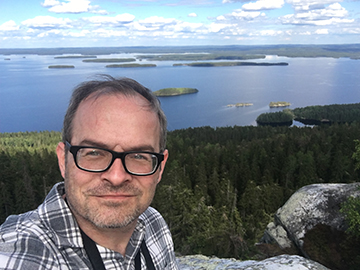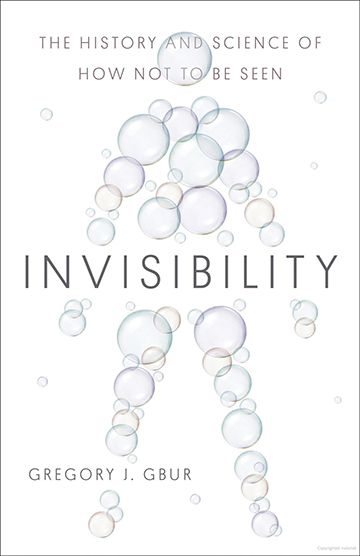
Greg Gbur [Image: Courtesy of G. Gbur]
When I first became a Ph.D. student in physics, my parents asked me the question dreaded by every physics major: “So, what is it that you are actually studying?” As scientists and engineers, we are (hopefully) trained to speak to a specialized audience, but we are given little to no training in how to describe our work to the general public. There are, of course, journalists and professional science communicators who provide these sort of explanations full time, but it never hurts to be able to talk about our own work in as simple and compelling terms as possible.
My path to science communication started in 2007, during the heyday of science blogging. I had been reading science blogs for a few years and was impressed by both the writing that was being done and the community that was growing. For almost 16 years now, I have been writing my own blog, “Skulls in the Stars,” where I talk about physics, optics, the history of science and whatever fun things capture my attention. This work directly led to my two popular-science books, Falling Felines and Fundamental Physics (2019) and Invisibility: The History and Science of How Not to Be Seen (2023), both published by Yale University Press. Every person’s path to writing a book is different, but here I will share how I did it and some insights I learned along the way.
Practice, practice, practice
One of the most vexing comments that I hear when I tell people I’m a physicist is something along the lines of, “I was never any good at math and physics.” I’m always bothered by this because people assume that science is something that you either understand or you don’t—and this binary discounts the value of practice. I regularly point out that I nearly failed algebra in junior high school, but now I do theoretical physics, thanks to lots of effort and repetition!
“Good science communication and writing also require a lot of practice, and there are many ways to get it.” —Greg Gbur
Good science communication and writing also require a lot of practice, and there are many ways to get it. For long-form writing, blog and newsletter sites are still active and vibrant. I have used WordPress and Tumblr, which have long been popular options, but these days there are many others as well. Substack is an electronic newsletter site that has become quite popular in recent years, and Patreon—though primarily a platform that helps content creators manage paid subscriptions—is often used by people with a substantial following to serve a similar purpose. A public Facebook page or Instagram account is another option for sharing scientific thoughts and images.
My own communication skills have improved tremendously over the years. Looking back at my oldest posts, they are filled with scientific equations and technical jargon, which could work as barriers to entry for nontechnical readers. A lot of my efforts have focused on almost entirely removing the math from popular science posts, and making no assumptions about the science background of the audience. This isn’t to say that I make my writing overly simplistic: I try to give enough detail and context to bridge the gap between journal articles and the short newspaper descriptions of discoveries.
(Social) networking
“Building an audience is important, and the best way to do this is through social media.” —Greg Gbur
Building an audience is important, and the best way to do this is through social media. Users can share short, conversational posts on websites and apps like Twitter, Bluesky and Mastodon, which may require a different tactic from long-form, blog-type posts.
Videos are another way to share scientific ideas. Producing videos requires a lot more planning and effort than prose, and I’ve never gotten into making them regularly, but I keep up with what other people are doing. TikTok is a popular platform where users upload short clips, typically 1 to 3 minutes long, on just about every topic imaginable, including science.
For longer videos, YouTube is still the go-to venue, and a lot of science podcasts also upload their recordings to the website. There are, incidentally, many science podcasts out there that are both entertaining and educational. Listening to them is another great way to learn good approaches to science communication.
Social media can provide a great opportunity to meet other online science communicators and learn new techniques and ideas. There is a vibrant community of such creators who are innovative and worth following. I’ve made a lot of very good friends through these online conversations and carried these friendships into the “real world.”
The world of professional publications

The cover of Greg Gbur's book, Invisibility: The History and Science of How Not to Be Seen.
After a few years of visibility on social media and in the blogosphere, I started to be approached by magazines to write short popular-science articles. I’ve written for OPN, American Scientist, La Recherche and others. Payment may or may not be offered for articles, depending on the publisher and their resources, but writing for such publications can be good experience working with an editor and polishing one’s writing beyond the “off-the-cuff” blog quality. I don’t usually approach magazines with ideas, as I don’t want to compete with professional science journalists, but I am happy to write an article on a subject I’m familiar with if I’m contacted.
On the book-publishing front, I began with textbooks before moving into popular science. Textbook writing is perhaps the simplest market for researchers to break into, as it is easy to directly approach publishers with ideas. For book proposals, a publisher will typically require an overview of the goals of the book, a table of contents and a sample chapter to highlight your writing style. The author’s profit from textbooks is usually quite low—there isn’t a huge audience, unless you manage to write a book that becomes a college course standard—and book advances usually aren’t a thing. One definitely doesn’t write a textbook for the money, but as an opportunity to make a lasting impression on the field.
I was quite lucky in writing my popular-science books, as I was approached directly by an editor at Yale University Press who had read my blog and followed my social media accounts. For maximum impact, however, most writers find an agent who will approach major publishing houses on their behalf to pitch book proposals. But finding an agent can be quite difficult, and I never had the motivation or time to secure one.
Authors don’t typically need an agent for working with a smaller university press, and for the moment that’s a path that I’ve been happy with. A downside: book advances are also going to be smaller (my advances have been in the thousands of dollars, to give an idea). Since I’m working full time as a professor anyway, this was an acceptable tradeoff for me. Another disadvantage is that small presses do not have the resources to send authors on paid promotional trips, which is why building an audience in advance through social media is crucial. With a smaller publisher, much of the promotion must be done by the author.
Benefits of nonacademic science writing
“Honing your communication skills can not only lead to fun writing opportunities, but it can also improve the readability of your own technical publications and grant proposals, and thus lead to very tangible scientific benefits.” —Greg Gbur
Is it necessary for a scientist or an engineer to learn to write for a popular audience? I would say it is not required, as it involves a lot of work, and researchers typically have too much to do already. But it can provide benefits.
Honing your communication skills can not only lead to fun writing opportunities, but it can also improve the readability of your own technical publications and grant proposals, and thus lead to very tangible scientific benefits. Furthermore, I have found that thinking about nontechnical scientific explanations has made me a better teacher. If you enjoy explaining science to nonscientists, or at least to your family members, it is a very worthwhile and rewarding endeavor.
Optica Fellow Greg Gbur is a professor of physics and optical science at the University of North Carolina at Charlotte, USA.
